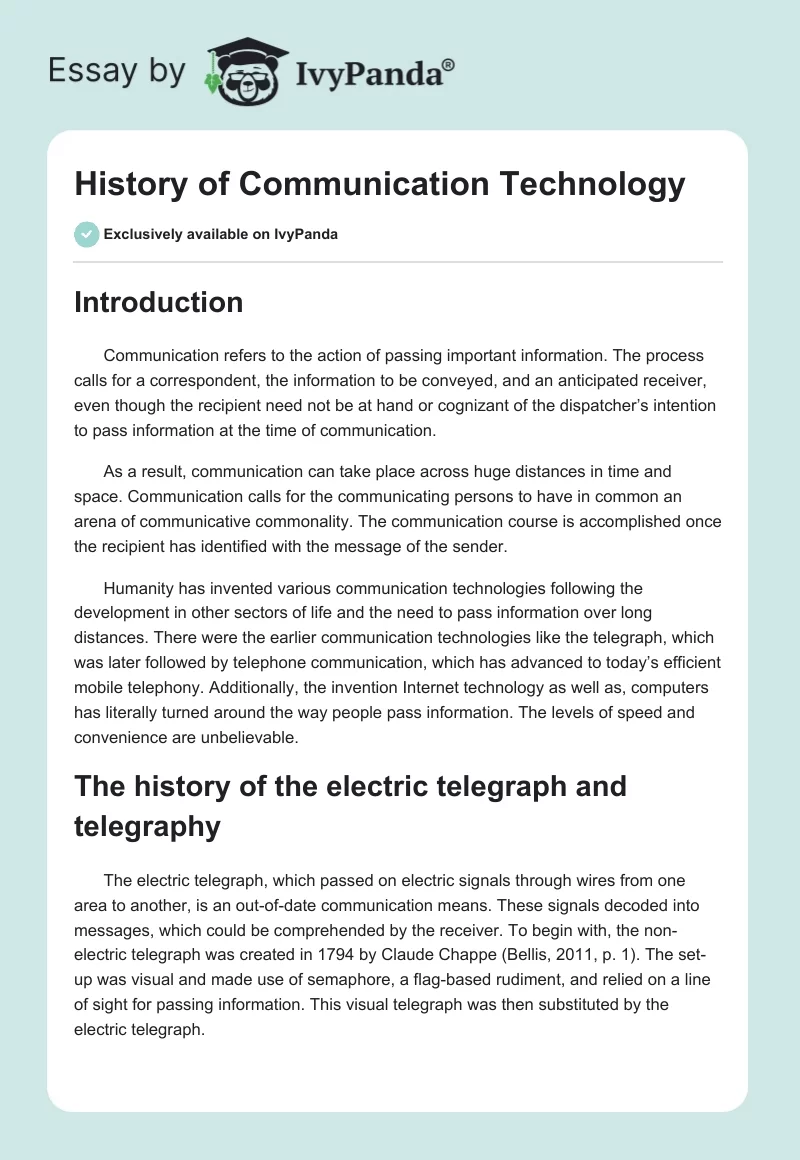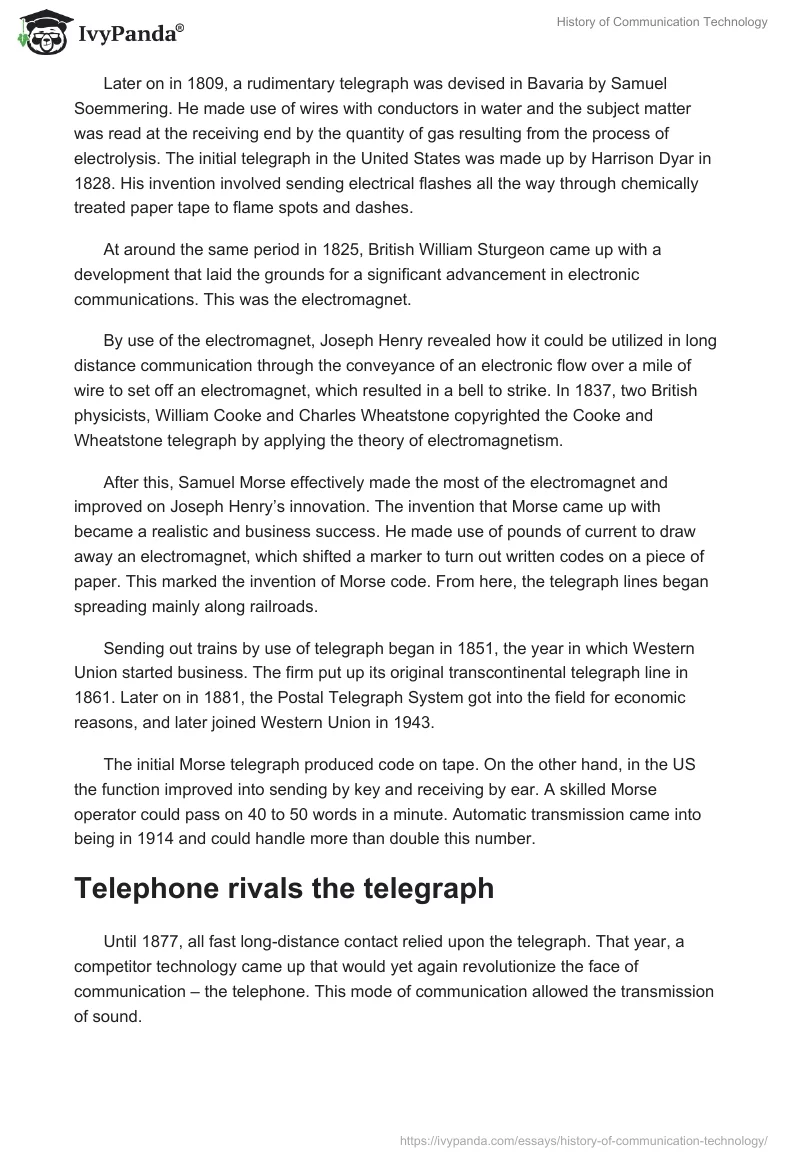Introduction
Communication refers to the action of passing important information. The process calls for a correspondent, the information to be conveyed, and an anticipated receiver, even though the recipient need not be at hand or cognizant of the dispatcher’s intention to pass information at the time of communication.
As a result, communication can take place across huge distances in time and space. Communication calls for the communicating persons to have in common an arena of communicative commonality. The communication course is accomplished once the recipient has identified with the message of the sender.
Humanity has invented various communication technologies following the development in other sectors of life and the need to pass information over long distances. There were the earlier communication technologies like the telegraph, which was later followed by telephone communication, which has advanced to today’s efficient mobile telephony. Additionally, the invention Internet technology as well as, computers has literally turned around the way people pass information. The levels of speed and convenience are unbelievable.
The history of the electric telegraph and telegraphy
The electric telegraph, which passed on electric signals through wires from one area to another, is an out-of-date communication means. These signals decoded into messages, which could be comprehended by the receiver. To begin with, the non-electric telegraph was created in 1794 by Claude Chappe (Bellis, 2011, p. 1). The set-up was visual and made use of semaphore, a flag-based rudiment, and relied on a line of sight for passing information. This visual telegraph was then substituted by the electric telegraph.
Later on in 1809, a rudimentary telegraph was devised in Bavaria by Samuel Soemmering. He made use of wires with conductors in water and the subject matter was read at the receiving end by the quantity of gas resulting from the process of electrolysis. The initial telegraph in the United States was made up by Harrison Dyar in 1828. His invention involved sending electrical flashes all the way through chemically treated paper tape to flame spots and dashes.
At around the same period in 1825, British William Sturgeon came up with a development that laid the grounds for a significant advancement in electronic communications. This was the electromagnet.
By use of the electromagnet, Joseph Henry revealed how it could be utilized in long distance communication through the conveyance of an electronic flow over a mile of wire to set off an electromagnet, which resulted in a bell to strike. In 1837, two British physicists, William Cooke and Charles Wheatstone copyrighted the Cooke and Wheatstone telegraph by applying the theory of electromagnetism.
After this, Samuel Morse effectively made the most of the electromagnet and improved on Joseph Henry’s innovation. The invention that Morse came up with became a realistic and business success. He made use of pounds of current to draw away an electromagnet, which shifted a marker to turn out written codes on a piece of paper. This marked the invention of Morse code. From here, the telegraph lines began spreading mainly along railroads.
Sending out trains by use of telegraph began in 1851, the year in which Western Union started business. The firm put up its original transcontinental telegraph line in 1861. Later on in 1881, the Postal Telegraph System got into the field for economic reasons, and later joined Western Union in 1943.
The initial Morse telegraph produced code on tape. On the other hand, in the US the function improved into sending by key and receiving by ear. A skilled Morse operator could pass on 40 to 50 words in a minute. Automatic transmission came into being in 1914 and could handle more than double this number.
Telephone rivals the telegraph
Until 1877, all fast long-distance contact relied upon the telegraph. That year, a competitor technology came up that would yet again revolutionize the face of communication – the telephone. This mode of communication allowed the transmission of sound.
The most fundamental role of this invention was to let two persons detached by great distances to talk to each other directly. It has developed over time from the use of wires to wireless devices that have proved to be more convenient and efficient (John, 2010, p. 304). Telephone communication has been regarded as crucial to enterprises, homes, and governments.
All phones have a microphone to talk into, an earpiece, which regurgitates the articulation of the other party, a ringer which produces a reverberation to indicate to the holder when there is an incoming call, and a keyboard to input the phone number of the telephone being called.
The mike and earpiece are normally built into a handset that is held up to the face to chat. The keyboard may be part of the handset or of a support part to which the handset would be linked. A landline phone is linked by a couple of wires to the telephone set of connections, while a cellular phone is moveable and corresponds with the telephone network by radio.
A wireless telephone has a moveable handset, which corresponds by radio with a base location linked by wire to the telephone network, and can just be used inside a restricted range of the base location.
The microphone switches the resonance signals to electrical signals, which are conveyed through the telephone network to the other phone. Here they are switched back to sound signals by the earpiece in the other phone’s handset. Phones are a duplex communication means; they permit persons on both ends to converse at the same time.
The phone set of connections, comprising of a worldwide set of phone lines linked by switching centers, permit any phone in the world to communicate with any other. Every phone has a distinguishing number referred to as its phone number. To set off a phone call, a chat with another phone, the user keys in the other phones’ number into a numeric keypad on the phone that they are holding.
Even though telephones were initially devised for voice communication, the set up has been customized for data transfer such as telex, fax, and dial-up internet communication.
Acknowledgment of the innovation of the electric phone is often disagreed upon and fresh debates over the matter have come up from time to time. In the same way as other innovations like radio, television, the light bulb, and the computer, there were a number of innovators who carried out groundbreaking investigational work on voice conveyance by way of a wire and progressed on each other’s thoughts. Among the names that contributed to the invention include, Innocenzo Manzetti, Antonio Meucci, Johann Phillip Reis, Elisha Gray, Alexander Graham Bell, and Thomas Edison.
The Internet
The story of the Internet begins in the 1950s and 60s with the innovation of computers. It commenced with the point-to-point contact involving central processing unit computers and visual display units, developed to point-to-point links involving computers and then early exploration into packet switching. In late 60s and the early 70s, a number of packet switched networks were built up (Abbate, 1999, p. 36).
These included; ARPANET, Telenet and CYCLADES. The ARPANET especially led toward the building up of protocols for internetworking. This permitted numerous detached networks to be linked jointly into a system of networks.
The Internet Protocol Suite was evened out in 1982 and the idea of a worldwide set of connections of completely interlinked TCP/IP systems referred to as the internet was set up. The right to use the ARPANET was spread out in 1981 when the National Science Foundation brought about the Computer Science Network.
The same was the case again in 1986 when NSFNET offered right of use of supercomputer sites In the US from exploration and learning institutions. Profit-making internet service providers began to surface in the late 1980s and 1990s. The ARPANET was withdrawn in 1990. The Internet was then marketed in 1995 following the withdrawal of NSFNET, which marked the taking away of the very last limitations on the use of the Internet to transmit marketable traffic.
From the middle of the 1990s, the Internet has a far-reaching effect on ways of life and doing business, together with the growing of near on the spot communication through electronic mail, direct messaging, VoIP, video calls, and the World Wide Web with its various chat sites and online shopping sites.
The exploration and learning population goes on with building up and utilizing highly developed networks. The Internet goes on with its growth, accelerated by ever-larger quantities of online information and awareness, business, leisure and social networking.
It is approximated that in 1993 the Internet held just 1% of the information moving in two-way telecommunication, by 2000 the number had gone up to 51%. Later by 2007, it had risen to a massive 97% of the entire telecommunicated information (Stewart, 2010, p. 1).
Progress of the Internet into space has grown by massive leaps and the initial live internet link into low earth course was instituted in early 2010. Astronaut T. J. Creamer placed the original unaided update to his Twitter account form the International Space Station. This marked the advancement of the Internet into space. Before this, astronauts had used electronic mail and Twitter with their communications being passed on to the ground by way of a NASA information connection. This was then posted by a human substitute.
Mobile phones and the Internet
The internet has been made available on mobile phones as technology advances. The initial mobile telephone with Internet was initiated in 1996. To make resourceful use of mobile phones and the Internet, a particular document and connection model was crafted for these devices, the Wireless Application Protocol (Richardson, 2008, p. 1).
It is commonly referred to as WAP and the majority of mobile appliance Internet provisions run using the WAP. The advancement of mobile telephony provision was at first a mainly Asian trend.
Historiography
A number of questions have emerged over the historiography of the Internet’s growth. Especially that it is not easy to come across documentation of much of the Internet’s advancement, for quite a number of grounds, together with a lack of central records for a great deal of the initial advances that led to the Internet.
Reference List
Abbate, Jane. 1999. Inventing the Internet. Cambridge: MIT Press.
Bellis, Mary. 2011. “The History of the Electric Telegraph and Telegraphy.” Web.
John, Richard. 2010. Network Nation: Inventing American Telecommunications. United States. Harvard University Press.
Richardson, James. 2008. “Mobile telephony.” Web.
Stewart, William. 2010. “Internet History – One Page Summary.” Web.


